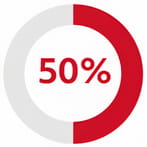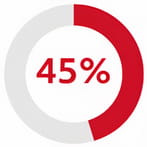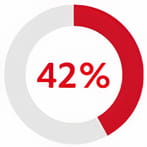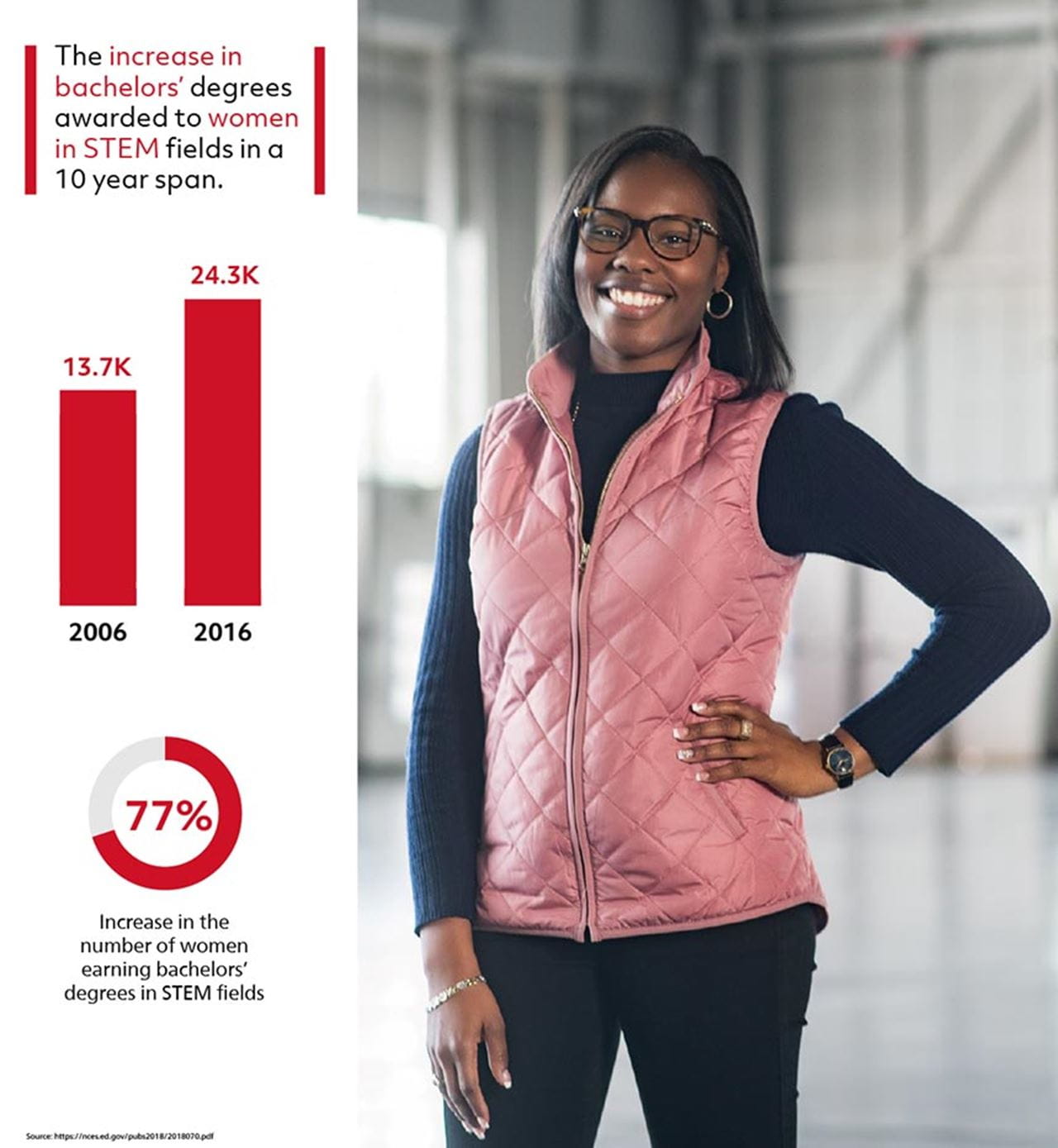
Environmental
The study of engineering and other STEM fields for improving the health of living organisms
Women engineers have shaped the world. Search engines, Bluetooth, Wi-Fi — many of the innovations we rely on today owe credit to the women who helped create them. But engineering and STEM majors weren’t always home to female innovators. A look back at 1949 shows there were less than 200 women enrolled in such fields.
Still, that didn’t stop women of previous generations from innovating. Even in times when women engineers were exceedingly rare, their contributions have been immense, from the technology that gave the Allies an edge, to solving the complex equations that put humans into space and on the moon.
In this article, you’ll learn about famous women engineers who shaped our world, educational benefits that are helping to grow the number of women in STEM fields, statistics that give a snapshot of how women are shaping the world of engineering, and career and mentoring tips for women innovators at different stages of their careers and education.
Women in engineering and mentorship
It can be difficult to break into a career if representation is limited. Alana Murphy is a director of system assurance at Raytheon Intelligence & Space, where she works with other engineers to ensure product quality and performance. With 19 years of experience working as an engineer, Murphy knows how to grow her career and help other women do so as well. Here, she shares tips for finding and being a mentor as well as growing a career in engineering.
How important are mentors for women engineers?
It is extremely important for female engineers to have mentors, someone who will listen but also help guide you toward what you define as success in your career. I always have a Board of Directors of mentors in my life. A mentor who is in the exact field I am in, a mentor to help me maneuver the political aspect, a mentor that is doing something I 'think' I might want to do next and a mentor I can ask the embarrassing questions.
How would you approach asking someone to be a mentor?
Just ask, “Would you be willing to be my mentor?”
Then give a couple of reasons for why you’d want them specifically to be your mentor. For example, “I would really like your mentorship because I admire the leadership skills I have seen you display during speaking events or during difficult discussions.” People always like hearing why you admire them.
Sometimes you will meet with a potential mentor a few times and it may not be a great fit. That’s okay.
What can young girls in elementary or high school start doing today to help them succeed as engineers in the future?
Start playing with all the online options as well as stuff you own in your room. There are robotics how-tos, free coding classes and everything on YouTube. Do not lose the spirit, no matter what happens.
What advice would you give to women who are graduating from college and starting their engineering careers?
Be willing to take on any and all tasks. The hard ones that no one wants usually get you the most visibility (you can figure out how to do the job once you say “yes.”) Also, earlier in your career is when you are usually the most mobile. Take advantage of that.
How do you know you’re ready to be a mentor?
As soon as you started your freshman year in engineering, you became a mentor as there is some little girl out there looking up to you. We are not as rare as unicorns anymore but we must encourage and mentor the next generation of engineers at each step of our life. You will never be 'ready.’ You jump in, learn, adjust and repeat that cycle for the rest of your life.

Environmental
The study of engineering and other STEM fields for improving the health of living organisms

Biomedical
The study of engineering principles applied to medicine and healthcare

Agricultural/Biological
The study of engineering and biology principles applied to agricultural and biological systems
Chemical
The study of chemical producing and manufacturing through chemical processes
Women in engineering scholarships
Not long ago, it was uncommon to see women studying engineering fields in college. As a result, there were far fewer women taking up professions in engineering. Scholarship awards for women in engineering and STEM fields are helping to change this.
Every year there are several hundred scholarships for female engineers in the United States, with total contributions coming in at over $1 million. But the competition for these scholarships can be steep, and they often only pay for a small portion of a degree. Luckily, an engineering scholarship isn’t the only way to get financial support for an engineering degree.
Employee tuition programs for engineering degrees
Many engineering companies offer tuition support to employees. By getting a foot in the door at an engineering company, even if the job isn’t directly in engineering, budding innovators can get the
financial support they need to gain an engineering related degree.
Raytheon Technologies offers an education benefit to full and part-time employees through two programs. Former Raytheon employees have access to the Education Assistance program and former UTC employees have access to the Employee Scholar Program. With both programs, employees are able to receive financial support while they pursue a career-developing degree, course or certification.
“We encourage folks to be life-long learners and re-skill themselves throughout their careers. We’ve provided opportunities for over 38,000 of our employees to get college degrees or certificates in the last 20 years. That’s over a billion in a half dollars,” said Raytheon Technologies CEO, Gregory Hayes in a Facebook Live event with Rhode Island Governor, Gina Raimondo.
Tina Oyeniya of Pratt & Whitney has made great use of the company’s education benefits.
“Raytheon Technologies has paid for my MBA from UConn as well as my master’s from MIT. So, yes, I stand here very proud that they afforded me that opportunity. I can’t imagine having to pay for either of those degrees. This company has definitely invested in me and I appreciate that,” said Tina Oyeniya.
Oyeniya works on ceramic matrix technology for Pratt & Whitney. She started her career 10 years ago, working on engine systems for the company. Oyeniya helps inspire the next generation of female innovators through her volunteer work with Girls Who Code.
Raytheon Technologies plans to release more information on its future, integrated Employee Scholar Program in the 4th Quarter.

Above: Tina Oyeniya of Pratt & Whitney has made good use of Raytheon Technologies’ education benefit and received full coverage for her MBA and Masters’.
Famous female engineers
Female engineers have created and innovated past and present advancements such as radio communications, space travel and search engines. They range from Hollywood actors turned radio engineers, to motorcycle racers and NASA engineers. The following are four remarkable female engineers who shaped our modern world.
Hedy Lamarr
Lamarr lived a storied life, working as an actress, film producer and inventor. During World War II she helped develop a torpedo radio guidance system for the Allies. Techniques based off of Lamarr’s system are seen in Bluetooth and Wi-Fi technology used today. In 2014, Lamarr was posthumously inducted into the National Inventors Hall of Fame.
Katharine Burr Blodget
Blodget was the first woman to receive a PhD in physics from the University of Cambridge. While working at General Electric, Blodget developed a form of invisible glass. This glass had almost no reflections and was used in Hollywood cameras as well as submarine periscopes and aviation spy cameras during World War II.
Beatrice Shilling
Shilling was a motorcycle racer and aeronautical engineer. During World War II she developed a fuel restrictor for Royal Air Force fighter planes. During nose dives, RAF planes would stall because the engine would flood with fuel. German pilots knew this and would use the nose dive as an effective evasive maneuver. Shilling’s fuel restrictor enabled RAF fighters to nosedive without stalling.
Katharine Johnson
Johnson was a mathematician and NASA employee. Her calculations were integral to early U.S. space missions. Her strong knowledge of analytical geometry enabled her to calculate launch windows, flight paths and emergency returns. She is a recipient of the presidential Medal of Freedom and Congressional Gold Medal. She was portrayed in the 2016 film Hidden Figures.
Women in engineering day
Women in Engineering Day is celebrated on June 23rd every year. It began in 2014 in the UK as part of the Women's Engineering Society’s celebration for its 95th anniversary. In 2017 it became an internationally recognized day.
The aim of Women in Engineering Day is to encourage women to take up interest in engineering fields and to celebrate the accomplishments of female engineers. People are encouraged to research the innovations of female engineers and share them with friends and colleagues.
Women in engineering statistics
Data shows that the number of women in engineering college programs and professions is growing. From 2010 to 2016 there was a 77% increase in bachelor’s degrees awarded to women in engineering and engineering technology fields.
What percentage of engineers are female?
16% of engineers are female.
What percentage of STEM and engineering majors are female?
In 2018 there were 136,233 engineering bachelor degrees awarded. Women earned almost 22% of engineering bachelor’s degrees that year for a total of approximately 29,970 degrees.
How many female engineers are there in the US?
The most recent compilation shows that there are 200,000 female engineers in the US.
Women in engineering jobs
The most popular areas of study for women in engineering are environmental, biological, agricultural, biomedical and chemical. A recent study found that 80% of female engineers are happy with their career choice. 98% find their job rewarding.
Unfortunately, many women leave their engineering careers. The most recent data shows there are 2.5 million women in the U.S. with STEM degrees. 27% of those women have left their engineering career. 16% did so because for family reasons.
It can be difficult for both women and men to return to an engineering career later in life after they have taken a break from the profession. Engineers can help restart their careers by:
Taking strategic volunteer roles. Engineers looking to return to work can reach out to their town and ask if there are engineering projects that they can provide volunteer help for. This could involve reviewing blueprints or engineering proposals for town projects.
Keep up their skill set. Online courses are one-way for engineers to keep their skills sharp while on a professional hiatus. Engineers returning to work should mention these courses in their cover letter when applying for jobs.
Attending conferences or professional organizations. This is a great way to reengage with engineering and build a professional network. Engineers returning to work can see what trends and changes have happened in the industries since they left.

Above: Raytheon Technologies’ Re-Empower Program enables engineers to relaunch their careers after taking a professional hiatus.
Another option for engineers looking to return to work after a professional hiatus is returnships. These programs are offered by companies as a sort of internship for adults returning to work. They often offer paid salary and training as well as the opportunity to transition into a full-time role.
Raytheon Technologies’ Re-Empower Program is a 14-week program in which participants gain paid, on-the-job experience and have an opportunity to network with leadership. They also develop personalized plans for success and receive coaching to guide their return to work experience. After completing the program, participants are eligible for a career at Raytheon Technologies.
“The Re-Empower Program was perfect because they paired us with ambassadors who helped acquaint us with Raytheon Technologies’ culture and how the company does business. Aspects such as diversity, inclusivity, cross-functional communication and influence, emotional intelligence, personal development, organization, and time management. For those of us who had not been in our field for several years, it was really helpful with getting us up to speed with the culture and the day-to-day functions and responsibilities of our jobs,” said Tani Foster, a subcontract manager of Global Supply for Raytheon Missiles and Defense.
Foster returned to the engineering industry after a 15 year professional hiatus. During that hiatus, Foster focused on raising her daughter and teaching and facilitating courses at the university level. She found Raytheon Technologies’ Re-Empower Program while searching for job opportunities that would get her back into the engineering industry.
“I told the HR department when I graduated from the Re-Empower Program that I had never been to an organization as a new employee where I received the extent of onboarding that I received at Raytheon Technologies. The care that they took in supporting us and getting us re-engaged in our field and acquainted with the company, there’s no other experience I’ve had quite like it.”
“From 2006 to 2016 there was a 77% increase in bachelor’s degrees awarded to women in engineering and engineering technology fields.”
https://nces.ed.gov/pubs2018/2018070.pdf Figure 325.45
“16% of engineers are female.”
“A look back at 1949 shows that were less than 200 women enrolled in such fields.”
https://nces.ed.gov/pubs2018/2018070.pdf Figure 325.45
“A recent study found that 80% of female engineers are happy with their career choice. 98% find their job rewarding.”
“The most popular areas of study for women in engineering are environmental, biological, agricultural and biomedical.”
“In 2018 there were 136,233 engineering bachelor degrees awarded. Women earned almost 22% of engineering bachelor’s degrees that year for a total of approximately 29,970 degrees.”
“The most recent data shows there are 2.5 million women in the U.S. with STEM degrees.”
https://files.eric.ed.gov/fulltext/ED523766.pdf
“27% of those women have left their engineering career. 16% did so because for family reasons.”
https://www.ncbi.nlm.nih.gov/pmc/articles/PMC5491652/
“The most recent compilation show that there are 200,000 female engineers in the US.”
https://www.nsf.gov/statistics/seind14/index.cfm/chapter-3/c3s5.htm#s1-1 appendix 3-13